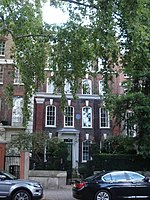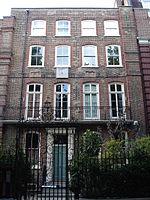Swan House, Chelsea Embankment
Grade II* listed buildings in the Royal Borough of Kensington and ChelseaGrade II* listed houses in LondonHouses completed in 1876Houses in the Royal Borough of Kensington and ChelseaQueen Anne Revival architecture in the United Kingdom ... and 2 more
Richard Norman Shaw buildingsUse British English from September 2019

Swan House is a Grade II* listed house at 17 Chelsea Embankment on the north bank of the River Thames in Chelsea, central London, England. Built in 1876 by the architect Richard Norman Shaw, architecturally it is relevant both to the Queen Anne Revival and to the Arts and Crafts movement. It was built by Shaw for the artistic patrons Wickham and Elizabeth Flower. Jones and Woodward, in their Guide to the Architecture of London, consider Swan House to be the "finest Queen Anne Revival domestic building in London."
Excerpt from the Wikipedia article Swan House, Chelsea Embankment (License: CC BY-SA 3.0, Authors, Images).Swan House, Chelsea Embankment
Chelsea Embankment, London Chelsea (Royal Borough of Kensington and Chelsea)
Geographical coordinates (GPS) Address External links Nearby Places Show on map
Geographical coordinates (GPS)
| Latitude | Longitude |
|---|---|
| N 51.48398 ° | E -0.16343 ° |
Address
Swan House
Chelsea Embankment 17
SW3 4LE London, Chelsea (Royal Borough of Kensington and Chelsea)
England, United Kingdom
Open on Google Maps










